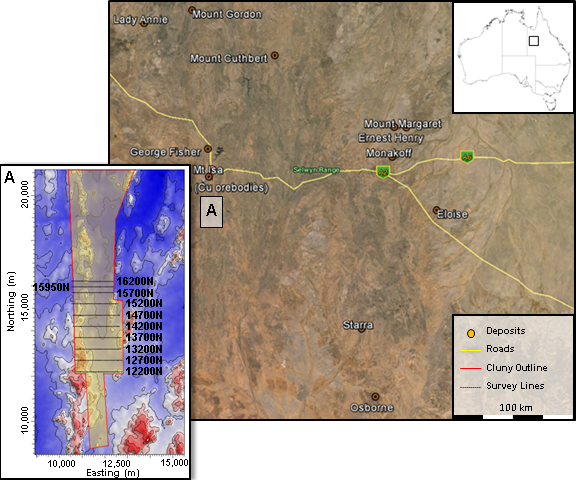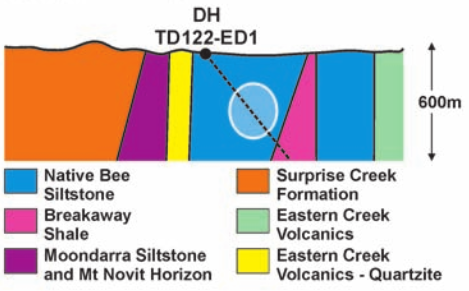Setup
The Mount Isa region (Fig. 444) hosts numerous deposits (Lead, Zinc, Silver, Copper, and Gold) within an area under continuous exploration. This region is found in west Queensland, Australia. Within this region, ten lines of direct current resistivity (DCR) and induced polarization (IP) data were acquired over what is now referred to as the Cluny Mine (Copper), 22 km south of the city of Mt Isa. Two primary questions that motivated the initial study were:
Can geophysical data and 3D inversion delineate the various units shown in the geologic section?
Can conductive and chargeable units, which would be potential targets within the siltstones, be identified?
In addition, we have an opportunity to re-invert the same data as Rutley et al [ROS01], but use improved algorithms and higher performance computers. Thus, a secondary set of questions is introduced as further motivation:
Are improved results obtained by using updated algorithms and higher performance computers?
Are there any lessons worth highlighting that arose within this case history that were not delineated in the initial case history paper?

Fig. 444 Location map of the Mount Isa area and (a) inset over the Cluny Prospect study area. Neighboring mineral deposits are shown for reference.
Geological Background

Fig. 445 Vertical cross section of geology from Mount Isa. The mineralisation occurs within the Native Bee Siltstone as shown by the circle.
The geology of the Cluny region and the southern extent of the Mt Isa lease is dominated by fault-repeated, steeply dipping stratigraphy of Native Bee Siltstone, Breakaway Shale, Moondarra Siltstone that incorporates the Mt Novit Horizon, Surprise Creek Formation, and Eastern Creek Volcanics as shown in Fig. 445. The Mt Novit Horizon consists of a sequence of mica schists, phyllites and metasiltstones containing gossanous material of coarse grained pyrite, pyrrhotite, and magnetite, with variable sphalerite, galena, marcasite, chalcopyrite, arsenopyrite and accessories [Rus78]. Exploration along this horizon has occurred over a 40 year period. The best drilling intersection recorded is from a 4 m interval containing 100 g/T Ag, 7.6% Pb and 11.6% Zn [Poo81].
At Cluny, copper mineralisation is frequently expected in conjunction with lead/zinc mineralisation. The Native Bee Siltstone and Moondarra Siltstone are considered to be favourable host stratigraphy for mineralisation. An exploration target in this area is a unit that is conductive and chargeable. In the geologic section Fig. 445 the exploration target is denoted by the circle within the Native Bee Siltstone.